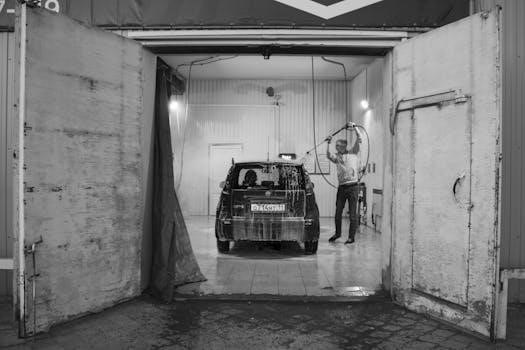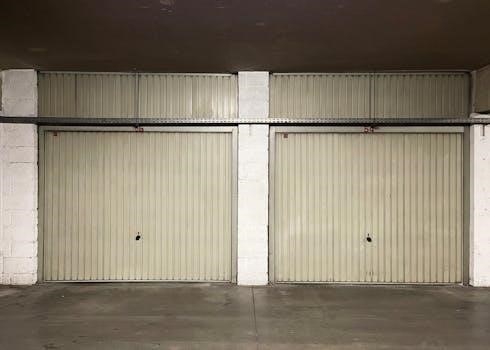Types of Garage Door Locks
Garage doors primarily utilize two main locking mechanisms⁚ manual locks and electronic locks. Manual locks are common, often easily installed, offering basic security. Electronic locks provide advanced features, sometimes integrating with smart home systems.
Manual Locks
Manual locks are a traditional method for securing garage doors, typically operated from inside. These locks often feature a simple sliding bolt or a key-operated mechanism. They are reliable and don’t rely on electricity. Some manual locks can be locked from the outside with a key and some require a padlock for added security. Manual locks may have a lever and a frame that slides into a slot.
Electronic Locks
Electronic locks for garage doors offer an advanced locking system, often integrated with automatic openers. These systems may include keypads or remote controls. While convenient, they typically don’t provide the manual locking mechanism. Most automatic openers do not actually lock garage doors, they only open and close them. Electronic locks enhance security but might require a manual backup during power outages.

Common Manual Lock Types
Manual garage door locks commonly include sliding bolt locks and T-handle locks. These are basic but effective for manual security. Some may include external key access, while others operate from inside.
Sliding Bolt Locks
These locks are a simple and effective method for securing a garage door. Typically, a metal bar slides horizontally into a slot on the door track, preventing the door from being opened. They are often located on the inside of the door. This type of lock is a common choice for manual operation and provides basic security by preventing the door from being lifted or pried open.
T-handle Locks
T-handle locks are designed for exterior use, often requiring a key for operation. These locks feature a handle shaped like a ‘T’ and are typically installed on the outside of the garage door. They control an internal mechanism that secures the door. These locks offer a convenient way to lock and unlock the garage from the outside, adding a layer of security that can be accessed with a key.
Manually Locking Process
Manually locking a garage door involves several steps. These include fully closing the door, locating the manual lock, and then engaging the locking mechanism. This process ensures the door is properly secured.
Closing the Door
The first crucial step in manually locking your garage door is ensuring it is fully closed. This means the door should be completely down and flush with the ground or the door frame. A partially open door cannot be effectively secured with a manual lock. It’s essential to confirm there are no obstructions preventing a complete closure before proceeding to the next step in the locking process.
Locating the Lock
After closing the door, the next step involves locating the manual lock mechanism. Typically, this is found on the inside of the garage door, often on one side or in the center. It could be a slide bolt, a handle, or a lever. The exact location might vary depending on the specific type and model of your garage door, so take a moment to find it.
Engaging the Lock
Once you have located the manual lock, you can proceed to engage it. If it’s a slide bolt, you will typically slide it horizontally into the corresponding slot on the door track. For other types, like a handle or lever, you may need to turn or push it into the locked position. Always ensure the lock is fully engaged.

Additional Security Measures
For enhanced security, consider adding a padlock to your manual lock. Installing a deadbolt on the garage entry door is also a great idea, creating an additional barrier to entry.
Padlock on Manual Lock
Adding a padlock to your manual garage door lock provides an extra layer of security. This simple measure can deter potential intruders by making forced entry more difficult. Ensure the padlock is robust and fits securely through the hasp or designated loop on the manual lock mechanism. Consider a hardened steel padlock for increased protection against cutting or tampering for maximum effectiveness.
Deadbolt on Garage Entry Door
Installing a deadbolt lock on the door leading from your garage into your home is crucial for enhanced security. This secondary lock makes it significantly harder for an intruder to gain access to your living space, even if they manage to bypass the main garage door lock. A robust deadbolt provides a strong physical barrier against forced entry attempts.
Safety Considerations
When manually locking your garage, always disengage the automatic opener to prevent damage. Ensure the door is fully closed before engaging any manual locks for optimal security and safety.
Disengaging Automatic Opener
Before manually locking your garage door, it is crucial to disengage the automatic opener. This action prevents potential damage to the opener mechanism and the door itself. Attempting to use the automatic opener while the door is manually locked can cause strain or breakage. Always ensure the opener is fully disengaged prior to manually engaging any lock. This ensures the longevity of both systems.
Fully Closed Door
Ensuring that the garage door is completely closed is a critical step before engaging any manual locking mechanism. A partially open door will not properly engage the lock, leaving your garage vulnerable. Always double-check that the door is flush with the ground and fully seated in its frame before proceeding. This action will provide complete security and prevent issues.
Manual Lock Problems
Manual garage door locks, despite their simplicity, can experience issues. These problems often include mechanical failures, such as a jammed or broken lock mechanism, requiring repair or replacement.
Mechanical Issues
Manual locks, while reliable, are prone to mechanical issues. These can include bent or broken locking bars, which prevent proper engagement. The sliding mechanisms may become stiff or jammed due to rust or debris accumulation. Internal parts may wear out over time, causing the lock to fail. Additionally, the latch may not align with the track, hindering locking. Regular maintenance is crucial to avoid these problems.

Types of Garage Doors
Garage doors come in various styles, including tilt-up and sectional doors. Each type may have unique locking mechanisms. Understanding your door type is crucial for selecting the correct lock.
Tilt-Up Doors
Tilt-up doors often feature a built-in manual locking mechanism, typically positioned in the middle or along the sides. These mechanisms can include sliding bars or a manual lock handle. Depending on the model, the lock engages with the door track or frame. Always ensure that the door is fully closed before attempting to engage any manual locking system for optimal security and safety, preventing forced entry effectively.
Sectional Doors
Sectional garage doors usually have manual locking mechanisms that engage with the vertical tracks. The locking system often involves a slide bolt or a latch that moves into a slot on the track. Some models may also use a T-handle lock, which requires a key for external operation. Ensure the door is fully closed before manually locking it to prevent any compromise in security and avoid potential damage.

Alternative Locking Methods
Beyond standard locks, consider track security, which prevents the door from being lifted, or a garage door shield, which covers the door’s access points. These methods offer enhanced protection against forced entry.
Track Security
Securing the garage door tracks can be achieved by placing obstructions such as vice grips or c-clamps above the rollers. Spring-loaded locks that slide a bar into the track openings can also be used. These methods prevent the door from being lifted or forced open, offering a good alternative to standard locks, enhancing overall garage security and making it harder for intruders to gain access.
Garage Door Shield
A garage door shield acts as an additional barrier against forced entry. It is a physical reinforcement that prevents the door from being pried open. It is a great option to make your garage even more secure. By making it more difficult for an intruder to access the door’s weak points, it adds another layer of protection to your existing locking system.
When to Use Manual Lock
Manual locks are essential during power outages when automatic openers fail. They also offer reliable security for long-term manual use of your garage door, ensuring it remains securely closed.
Power Outage
During a power outage, your automatic garage door opener will not function, making a manual lock crucial. This ensures you can still secure your garage. By engaging the manual lock, you create a reliable barrier against unauthorized access, maintaining safety even when electricity is unavailable. This is a vital backup for ensuring your property remains protected.
Long Term Manual Use
If a garage door is to be operated manually for an extended period, it’s essential to understand the built-in safety features. Most garage doors have a manual locking system, often a handle in the middle of the door. Regular checks and maintenance are vital to ensure proper function and security. Knowing how the manual mechanism works keeps your garage door safe for long-term manual operation.